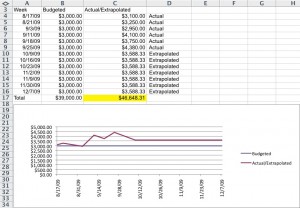Cross Footing and Run Rate Exhaustion, Part 2
By Craig Covello, PMP:
In part one of this two-part series, we looked at cross footing to find spreadsheet errors. This month, we look at a possible early warning sign of overspending.
Run Rate Exhaustion
Every project has two primary appetites. One involves purchases of equipment. The other consumes money in the form of labor. If this labor is defined as “time and materials” without any capitation, the project is vulnerable to budget overruns. One way to mitigate the problem is to make a prediction using something I like to call “run rate exhaustion”. The technique is simple. Team members provide the project manager with an estimate of hours required, before the project starts, as part of the budget process. Once the project is underway, the actual hours expended by each team member are recorded, averaged and used to extrapolate hours for the remainder of the project.
Note – Click on graphic for better resolution.
If the extrapolated figure exceeds the original staff estimate, then there is a chance of exhausting your labor budget before the project completes. Of course, this extrapolation technique is more art than science because it assumes that the hourly burn rate is somewhat linear. You might need to incorporate some refinement by adjusting a specific team member’s end date relative to the project completion date. But even with its limitations, extrapolating run rates can be a very effective tool. It allows you to identify potential labor cost overruns and take corrective action, hopefully before the situation becomes a threat to your project budget.
Drop me a line if you decide to use either of these techniques and later discover that they saved you from falling off the budgetary cliff. Then share your story with the United States Congress, since it appears that they struggle with some of these budget-oversight concepts. The Senate may have miscalculated by about $13.7 trillion. It was probably a spreadsheet error. 😉 http://www.usdebtclock.org/




